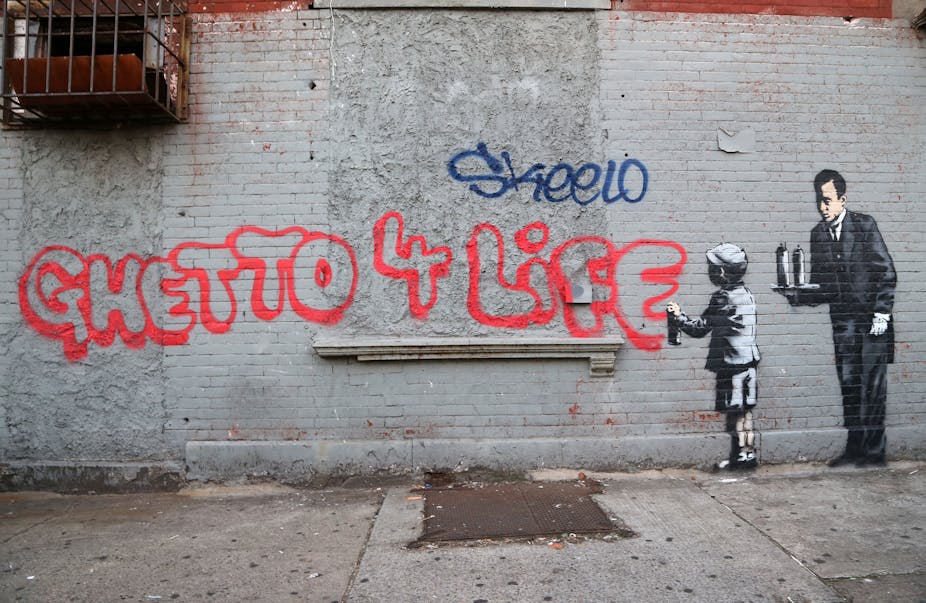Street art is the name given to artworks placed in public, usually without permission – and Banksy is probably the most famous street artist in the world. Last week he completed a residency in New York City that has, characteristically, subverted conventions about how art gets made, funded and interpreted.
The British street artist has a reputation for witty, appealing street artworks – and he is also one of the most significant and collectible contemporary artists, with his works on canvas being sold at auction for as much as US$1,870,000. In addition, he has made an Oscar-nominated film, Exit Through The Gift Shop, and published a bestselling book, Wall and Piece, as well as inspiring countless street artists to imitate his style.
After a long period of apparent inactivity, Banksy spent October undertaking what he called a “residency” in New York, with the moniker “Better Out Than In”. His month-long stay generated a popular frenzy to spot each work as soon as it was installed, and in some cases, to remove it for profit.
A residency is conventionally assumed to offer an artist studio space and uninterrupted time in which to make art; but Banksy’s New York residency subverted those conventions.
First, no invitation to spend time in New York had been issued; the artist simply went there and installed his work. Some local artists expressed resentment at the media attention Banksy’s presence generated, complaining that street artists were at work in New York every day of the year and Banksy was stealing some thunder that could have been directed towards home-grown talent.

Secondly, the creative activity behind the works also took place long before his residency began – rather than evolving in response to it. Banksy produced artworks almost every day of the month that he was there, some of which were complex, with multiple components such as audio commentaries posted on his website or available on smart phone to locals (spoofs of the typical audio guide in many museums).
In several pieces, people had been hired to play roles such as “security guard” or “market seller”. The additional personnel and the extent of the artworks’ prior planning were hidden behind a residency’s implication of a singular artist and a limited period of time.
Finally, whereas residencies usually necessitate gratitude towards funding bodies, many of Banksy’s installations invited a critical response to our attitudes towards the support of art.

In this respect, the residency’s most significant works showed awareness of contradictions in how we even define something as “art”. One work, a collaboration with the Brazilian street artists os gemeos, involved two pieces displayed in a street close to Chelsea’s expensive galleries.
The work was accompanied by a viewing bench, a security guard, and a cooler filled with cheap white wine, an apparent dig at the ways in which galleries require us to view art.
In another work, an elderly man sold signed Banksy canvasses for US$60 from a street stall outside Central Park.
Accustomed to ubiquitous Banksy rip-offs, almost every passer-by ignored the works, oblivious to their actual value (in the thousands of dollars for each canvas).
On a subsequent day, Banksy left a work on canvas in a thrift store. The painting was then sold at auction, raising US$608,000 for a charity working with homeless and HIV-positive individuals.
In these works, it’s clear both the commercial value of his pieces and the audience reactions to the very idea of “Banksy” are becoming part of his art, making Banksy perhaps the most conceptual street artist working today.

But what was it all for?
Banksy’s last NYC work – a giant inflatable tag suspended from a wall – provides a clue. With this work, at the very end of his residency, Banksy finally issued an “artist’s statement”. The commentator in the work’s audio guide informs us:
Banksy asserts that outside is where art should live, amongst us. And rather than street art being a fad, maybe it’s the last thousand years of art history that’s a blip, when art came inside in service of the church and institutions. But art’s rightful place is on the cave walls of our communities where it can act as a public service, provoke debate, voice concerns, forge identities.
The world we live in today is run – visually at least – by traffic signs, billboards and planning committees. Is that it? Don’t we want to live in a world made of art, not just decorated by it?
So despite all his commercial success and all the fandom surrounding his work, Banksy still stands by the very idea of street art as art in the street, for the public, installed without permission. Not for nothing was his residency named “Better Out Than In”.

Alison Young is presenting the 2013 John V. Barry Memorial Lecture in Criminology, entitled “Just Images’?: On the Troubling Relationship between Crime, Culture and Spectatorship” at the University of Melbourne on November 14 at 6.30pm.

